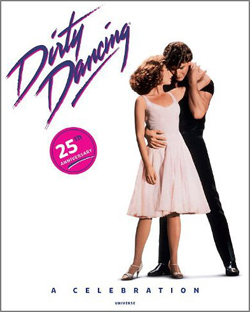For almost 80 years, Kirkus Reviews has served as the industry bible for bookstore buyers, librarians, and ordinary readers alike. Now Popdose joins the Kirkus Book Bloggers Network to dish on the best — and sometimes the worst — in pop-culture and celebrity books.
This week, a lavish photo book pays tribute to a classic of 1980s cinema. Will reviewer Jack Feerick have the time of his life?
 Although it’s now one of the iconic films of the 1980s (and certainly one of the most quoted), Dirty Dancing was a box office dark horse upon its release. A teen movie for former teenagers, set in the Jewish summer resorts of the Catskills — a milieu that was fading even in 1963, when the movie is set — it was seen as a nostalgia piece. It might connect with a core market of Boomers, but was considered a longshot to bring in the all-important youth audience.
Although it’s now one of the iconic films of the 1980s (and certainly one of the most quoted), Dirty Dancing was a box office dark horse upon its release. A teen movie for former teenagers, set in the Jewish summer resorts of the Catskills — a milieu that was fading even in 1963, when the movie is set — it was seen as a nostalgia piece. It might connect with a core market of Boomers, but was considered a longshot to bring in the all-important youth audience.
But the screenplay — based loosely on writer-producer Eleanor Bergstein’s own experiences — connected with audiences young and old, who recognized their own idealism in the heroine ”Baby,” played by Jennifer Grey. Oh, and a star-making turn from a chiseled and largely-shirtless Patrick Swayze certainly didn’t hurt.
But there’s more going on in Dirty Dancing than pelvic grinds and oiled chests. The evocation of the early 1960s — often romanticized as a time before America’s collective loss of innocence — has a delicate edge of self-mockery; there’s plenty that’s grim and seedy, even in the self-contained world of the summer resort. Baby, like a lot of young people, has ambitions to save the world, but finds herself overwhelmed by injustices on her own doorstep, injustices for which her upper-middle-class upbringing has not prepared her. Given how reluctant American movies are to tackle socioeconomic issues at all, Dirty Dancing doesn’t shy away from the resentments of those on the wrong side of the service economy, or from the unearned sense of entitlement of the managerial class; you can spot the bad guy because he’s toting around a copy of The Fountainhead. There’s a critical essay to be written unpacking the film’s treatment of the class divide — and its decision to elide the related questions of religion and ethnicity in its romance between the Jewish Baby and the gentile Johnny.
You won’t find that essay here, though. Nor will you find any discussion of the film’s use of music, blending pop tracks new and old to evoke place and mood. Nor will you find any unpacking of the ways in which Dirty Dancing both influenced and was influenced by the rise of the MTV music video, or any one of another half-dozen interesting things that could be said about the film…
Read the rest of this article at Kirkus Reviews!





Comments